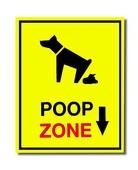Emergency Vet Clinic in Brampton, Highway 10
Clearing The Minefield
Backyard Spring Cleaning With A Dog
 It’s been a winter for the record books here in Southern Ontario, with cold temperatures and snowfall accumulation not seen in a generation. From November straight to mid-March, it seemed like we were getting snowed on near daily. This is now presenting dog owners with a new seasonal dilemma as spring weather approaches; the melting snow is leaving behind a near 5-month mess of dog droppings sitting atop the yard.
It’s been a winter for the record books here in Southern Ontario, with cold temperatures and snowfall accumulation not seen in a generation. From November straight to mid-March, it seemed like we were getting snowed on near daily. This is now presenting dog owners with a new seasonal dilemma as spring weather approaches; the melting snow is leaving behind a near 5-month mess of dog droppings sitting atop the yard.
The pristine scene of a white blanketed backyard is being replaced by a mushy, smelly and unsanitary mix of mud, grass and poop. Your mission, should you choose to accept it (and you really should), is to make the yard a safe place once again for pets, plants and people.
Mission: Spring Cleaning
Let’s face it, we’ve all been gearing up for a bit of spring cleaning anyhow. Many people choose to target a different room of their house every day during a spring cleaning blitz, so why not just add the backyard to your list of rooms to tackle?
Location: Backyard
I would recommend starting your mission outside, as you otherwise run the risk of tidying the inside only to have outdoor pollutants tracked in on sullied footwear and dog paws. Nobody wants dog poop on the clean floors. That’s just counterproductive.
Threat Assessment: Bacterial contaminants impacting the health of the grass, flowers, children and pets
This is likely not surprising, but dog fæces contain many forms of bacteria, viruses and parasites, some of which can be very dangerous when transmitted to other animals or humans.
Some of the travelers that can be found in dog fæces:
- Campylobacteriosis
produces fever, vomiting, swollen lymph nodes - Salmonellosis
produces fever, shock, lethargy, dehydration, & other symptoms - Toxocarisis (roundworms)
produces vomiting, diarrhea, worms in fæces - Coccidia
produces bloody diarrhea, vomiting, dehydration & other symptoms - Cysticerosis (tapeworms)
produces anemia, anorexia - E.coli, Giardia, Parvo
produces diarrhea, vomiting, can be fatal if untreated
If that doesn’t make you want to clean up after a winter of dog-doos, I’m not sure anything will. So what’s the best way to deal with the waste?
First off, get the whole yard cleared of mess. If some of the fæces are too soft for a clean pick-up, do as best you can and then hose down what remains. It is much easier to manage your backyard cleanup on an ongoing basis if you start with a clean slate.
You may also wish to contact your municipal government to see if they have any bylaws regarding the disposal of dog waste, as some regions require these to be disposed of as hazardous waste.
For suggestions on how to best manage your backyard cleanup, The Housebreaking Bible has some excellent tips in their article, ‘What To Do with Poo (The Art & Science of Dog Poop Displosal)’. Whatever plan works for you, stick with it, and reap the rewards of a tidy and safe backyard for the whole family to enjoy.
For more suggestions on how to maintain a safe play space for pets and children, contact your veterinarian today.